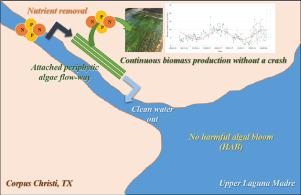Water Research ( IF 12.8 ) Pub Date : 2021-01-06 , DOI: 10.1016/j.watres.2021.116816 Sungwhan Kim , Carlos Quiroz-Arita , Eric A. Monroe , Anthony Siccardi , Jacqueline Mitchell , Nathan Huysman , Ryan W. Davis

|
The purpose of this study is to determine the potential for an attached algae flow-way system to efficiently produce algal biomass in estuarine surface waters by utilizing dilute non-point source nutrients from local urban, industrial, and agricultural discharges into the Upper Laguna Madre, Corpus Christi, Texas. The study was conducted over the course of two years to establish seasonal base-line biomass productivity and composition for bioproducts applications, and to identify key environmental factors and flow-way cohorts impacting biomass production. For the entire cultivation period, continuous ash-free biomass production at 4 to 10 g/m2/day (corresponding to nutrient recovery at 300 to 500 mg of nitrogen/m2/day and 15 to 30 mg of phosphorus/m2/day) was successfully achieved without system restart. Upon start-up, a latency period was observed which indicates roles for species succession from relatively low productivity, high ash content pioneer periphytic culture composed primarily of benthic diatoms from the source waters to higher productivity, reduced ash content, and more resilient culture mainly composed of filamentous chlorophyta, Ulva lactuca. Principal Component Analysis (PCA) was used to identify environmental factors driving biomass production, and machine learning (ML) models were constructed to assess the predictive capability of the data set for system performance using the local multi-season environmental variations. Environmental datasets were segregated for ML training, validation, and testing using three methods: regression tree, ensemble regression, and Gaussian process regression (GPR). The predicted ash-free biomass productivity using ML models resulted in root-squared-mean-errors (RSME) from 1.78 to 1.86 g/m2/day, and R2 values from 0.67 to 0.75 using different methods. The greatest contributor to net productivity was total solar irradiation, followed by air temperature, salinity, and pH. The results of the study should be useful as a decision-making tool to application of attached algae flow-ways for biomass production while preventing algal blooms in the environment.
中文翻译:

德克萨斯州拉古纳马德雷上游藻类流道在生物量生产与稀薄面源养分利用耦合中的应用
这项研究的目的是通过利用从当地城市,工业和农业排放到拉古纳马德雷河上游的稀薄面源养分,确定附着的藻类水流系统在河口地表水中有效生产藻类生物质的潜力。德克萨斯州科珀斯克里斯蒂市。这项研究历时两年,旨在确定季节性基线生物量生产力和生物产品应用的组成,并确定影响生物量生产的关键环境因素和流动队列。在整个培养期间,连续无灰生物量生产为4至10 g / m 2 /天(对应于300至500 mg氮/ m 2 /天和15至30 mg磷/ m 2的养分回收率)/ day)已成功实现,而无需重新启动系统。在启动时,观察到一个潜伏期,该潜伏期表明物种继承相对较低的生产力,高灰分的先驱附生物培养(主要由源水底栖硅藻组成)到较高的生产力,降低的灰分,以及更具复原力的养殖(主要由丝状绿藻,Ulva lactuca。使用主成分分析(PCA)来确定驱动生物量生产的环境因素,并使用局部多季节环境变化来构建机器学习(ML)模型以评估数据集对系统性能的预测能力。使用三种方法对环境数据集进行了ML训练,验证和测试,以进行ML分离:回归树,集成回归和高斯过程回归(GPR)。使用ML模型预测的无灰生物量生产率导致均方根误差(RSME)为1.78至1.86 g / m 2 /天,R 2使用不同的方法将其从0.67设置为0.75 净生产率的最大贡献是太阳总辐射量,其次是气温,盐度和pH。研究的结果应作为决策工具,用于将附着的藻类水流运用于生物质生产,同时防止环境中的藻华。

























 京公网安备 11010802027423号
京公网安备 11010802027423号